Role of Adults in Children's Play
VerifiedAdded on 2022/12/30
|8
|2453
|69
AI Summary
This assessment explores the role of adults in children's play through observation and commentary. It highlights the importance of adults in creating a supportive and fun environment for children's learning and development.
Contribute Materials
Your contribution can guide someone’s learning journey. Share your
documents today.
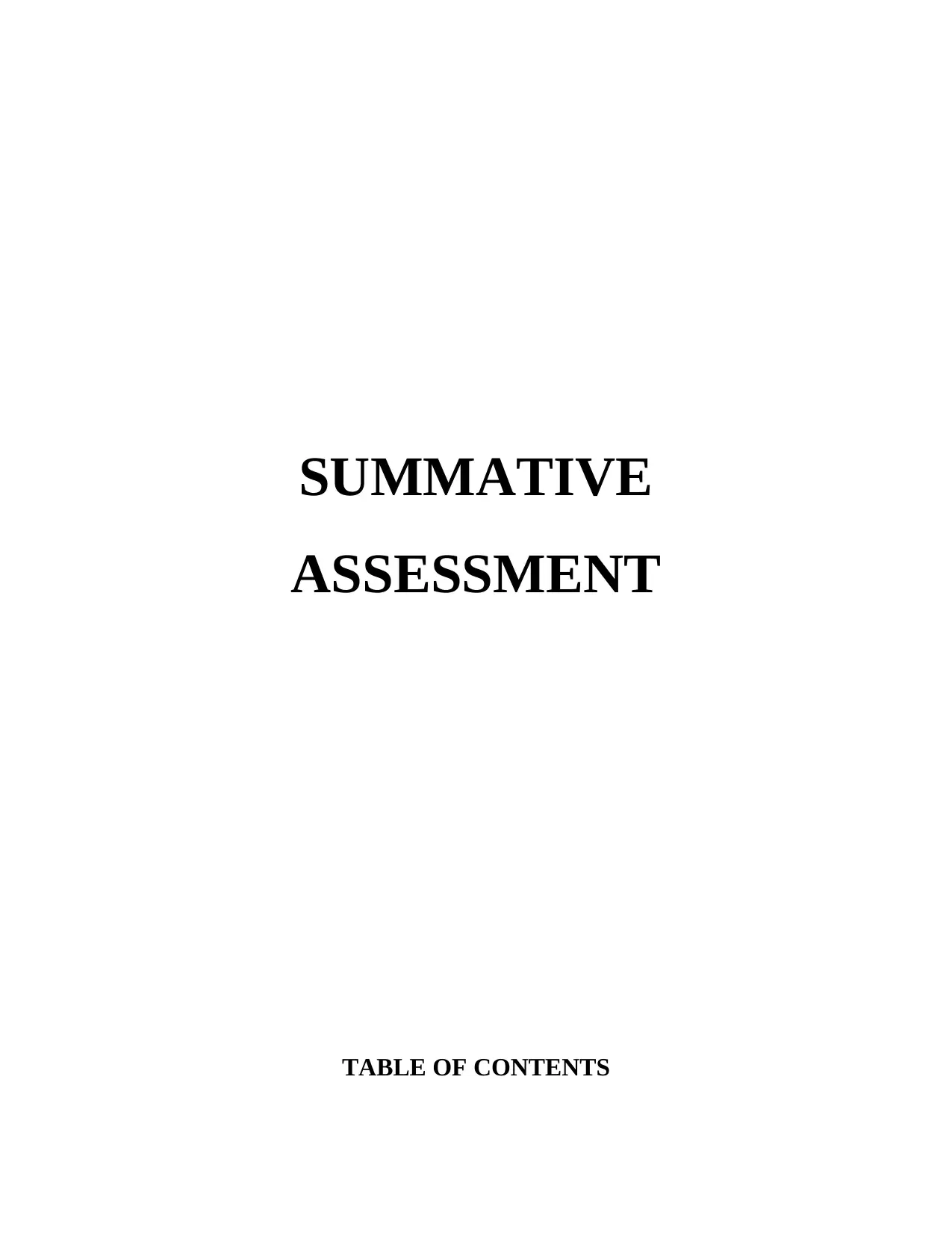
SUMMATIVE
ASSESSMENT
TABLE OF CONTENTS
ASSESSMENT
TABLE OF CONTENTS
Secure Best Marks with AI Grader
Need help grading? Try our AI Grader for instant feedback on your assignments.

INTRODUCTION...........................................................................................................................3
MAIN BODY..................................................................................................................................3
OBSERVATION.........................................................................................................................3
COMMENTARY........................................................................................................................4
CONCLUSION................................................................................................................................8
MAIN BODY..................................................................................................................................3
OBSERVATION.........................................................................................................................3
COMMENTARY........................................................................................................................4
CONCLUSION................................................................................................................................8
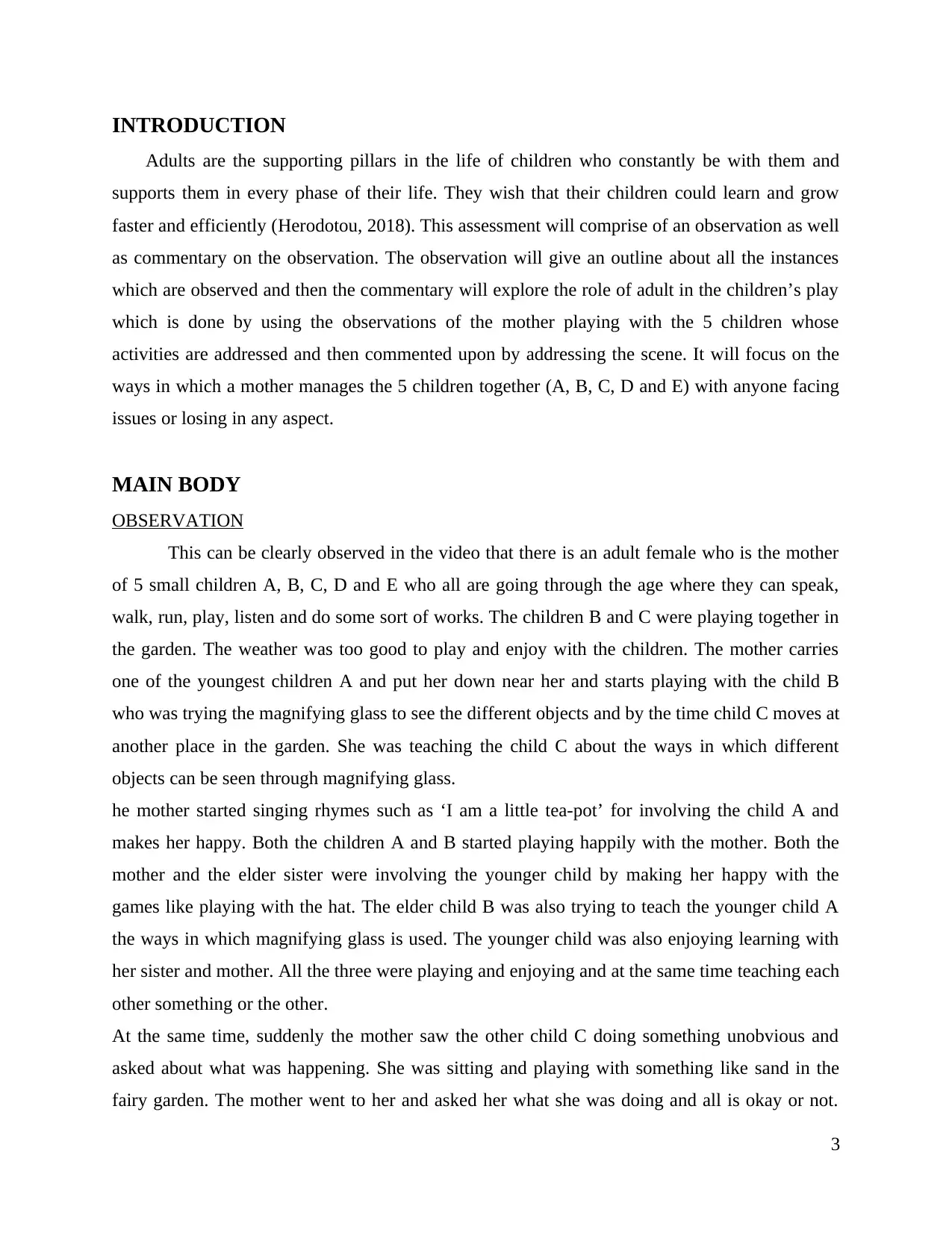
INTRODUCTION
Adults are the supporting pillars in the life of children who constantly be with them and
supports them in every phase of their life. They wish that their children could learn and grow
faster and efficiently (Herodotou, 2018). This assessment will comprise of an observation as well
as commentary on the observation. The observation will give an outline about all the instances
which are observed and then the commentary will explore the role of adult in the children’s play
which is done by using the observations of the mother playing with the 5 children whose
activities are addressed and then commented upon by addressing the scene. It will focus on the
ways in which a mother manages the 5 children together (A, B, C, D and E) with anyone facing
issues or losing in any aspect.
MAIN BODY
OBSERVATION
This can be clearly observed in the video that there is an adult female who is the mother
of 5 small children A, B, C, D and E who all are going through the age where they can speak,
walk, run, play, listen and do some sort of works. The children B and C were playing together in
the garden. The weather was too good to play and enjoy with the children. The mother carries
one of the youngest children A and put her down near her and starts playing with the child B
who was trying the magnifying glass to see the different objects and by the time child C moves at
another place in the garden. She was teaching the child C about the ways in which different
objects can be seen through magnifying glass.
he mother started singing rhymes such as ‘I am a little tea-pot’ for involving the child A and
makes her happy. Both the children A and B started playing happily with the mother. Both the
mother and the elder sister were involving the younger child by making her happy with the
games like playing with the hat. The elder child B was also trying to teach the younger child A
the ways in which magnifying glass is used. The younger child was also enjoying learning with
her sister and mother. All the three were playing and enjoying and at the same time teaching each
other something or the other.
At the same time, suddenly the mother saw the other child C doing something unobvious and
asked about what was happening. She was sitting and playing with something like sand in the
fairy garden. The mother went to her and asked her what she was doing and all is okay or not.
3
Adults are the supporting pillars in the life of children who constantly be with them and
supports them in every phase of their life. They wish that their children could learn and grow
faster and efficiently (Herodotou, 2018). This assessment will comprise of an observation as well
as commentary on the observation. The observation will give an outline about all the instances
which are observed and then the commentary will explore the role of adult in the children’s play
which is done by using the observations of the mother playing with the 5 children whose
activities are addressed and then commented upon by addressing the scene. It will focus on the
ways in which a mother manages the 5 children together (A, B, C, D and E) with anyone facing
issues or losing in any aspect.
MAIN BODY
OBSERVATION
This can be clearly observed in the video that there is an adult female who is the mother
of 5 small children A, B, C, D and E who all are going through the age where they can speak,
walk, run, play, listen and do some sort of works. The children B and C were playing together in
the garden. The weather was too good to play and enjoy with the children. The mother carries
one of the youngest children A and put her down near her and starts playing with the child B
who was trying the magnifying glass to see the different objects and by the time child C moves at
another place in the garden. She was teaching the child C about the ways in which different
objects can be seen through magnifying glass.
he mother started singing rhymes such as ‘I am a little tea-pot’ for involving the child A and
makes her happy. Both the children A and B started playing happily with the mother. Both the
mother and the elder sister were involving the younger child by making her happy with the
games like playing with the hat. The elder child B was also trying to teach the younger child A
the ways in which magnifying glass is used. The younger child was also enjoying learning with
her sister and mother. All the three were playing and enjoying and at the same time teaching each
other something or the other.
At the same time, suddenly the mother saw the other child C doing something unobvious and
asked about what was happening. She was sitting and playing with something like sand in the
fairy garden. The mother went to her and asked her what she was doing and all is okay or not.
3
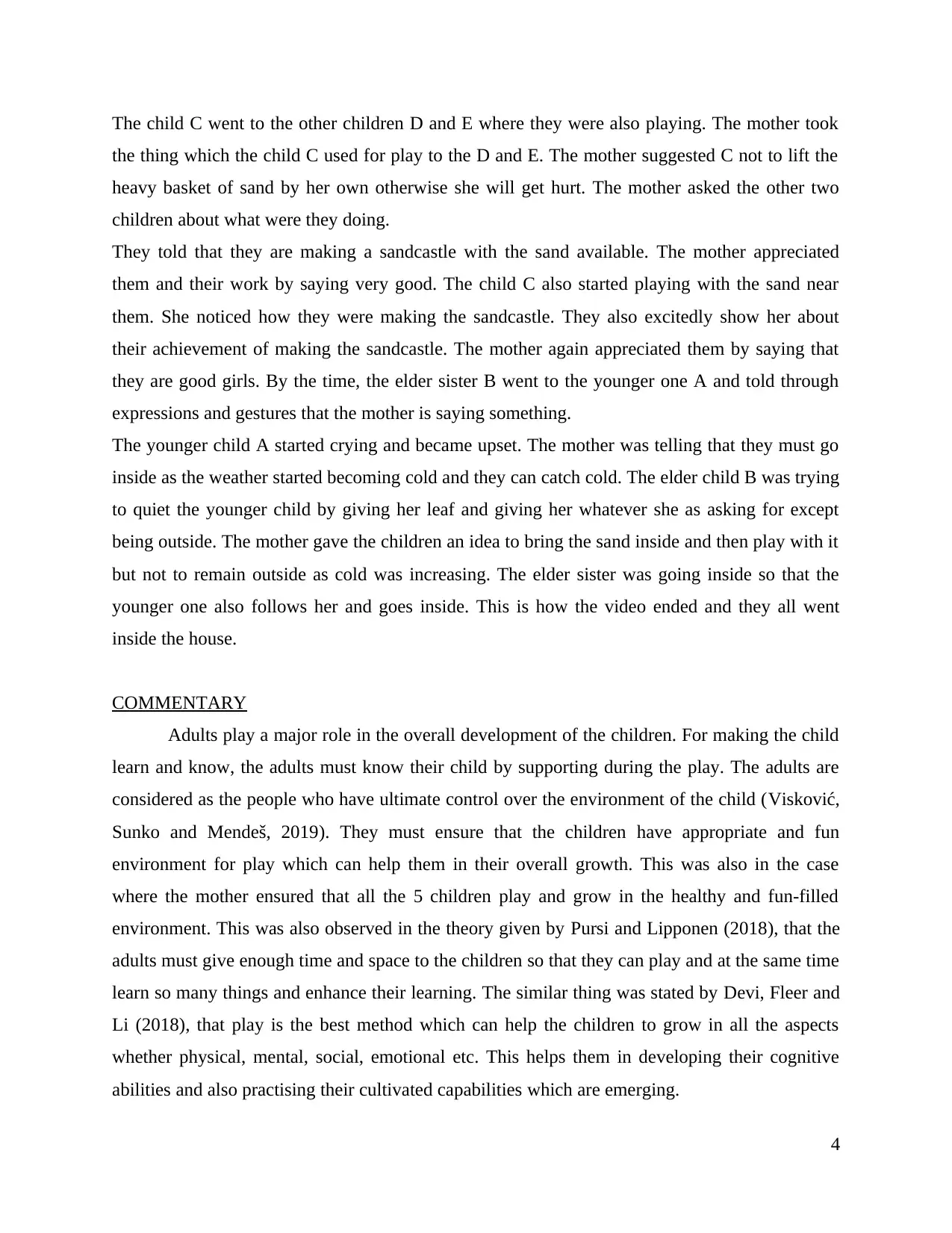
The child C went to the other children D and E where they were also playing. The mother took
the thing which the child C used for play to the D and E. The mother suggested C not to lift the
heavy basket of sand by her own otherwise she will get hurt. The mother asked the other two
children about what were they doing.
They told that they are making a sandcastle with the sand available. The mother appreciated
them and their work by saying very good. The child C also started playing with the sand near
them. She noticed how they were making the sandcastle. They also excitedly show her about
their achievement of making the sandcastle. The mother again appreciated them by saying that
they are good girls. By the time, the elder sister B went to the younger one A and told through
expressions and gestures that the mother is saying something.
The younger child A started crying and became upset. The mother was telling that they must go
inside as the weather started becoming cold and they can catch cold. The elder child B was trying
to quiet the younger child by giving her leaf and giving her whatever she as asking for except
being outside. The mother gave the children an idea to bring the sand inside and then play with it
but not to remain outside as cold was increasing. The elder sister was going inside so that the
younger one also follows her and goes inside. This is how the video ended and they all went
inside the house.
COMMENTARY
Adults play a major role in the overall development of the children. For making the child
learn and know, the adults must know their child by supporting during the play. The adults are
considered as the people who have ultimate control over the environment of the child (Visković,
Sunko and Mendeš, 2019). They must ensure that the children have appropriate and fun
environment for play which can help them in their overall growth. This was also in the case
where the mother ensured that all the 5 children play and grow in the healthy and fun-filled
environment. This was also observed in the theory given by Pursi and Lipponen (2018), that the
adults must give enough time and space to the children so that they can play and at the same time
learn so many things and enhance their learning. The similar thing was stated by Devi, Fleer and
Li (2018), that play is the best method which can help the children to grow in all the aspects
whether physical, mental, social, emotional etc. This helps them in developing their cognitive
abilities and also practising their cultivated capabilities which are emerging.
4
the thing which the child C used for play to the D and E. The mother suggested C not to lift the
heavy basket of sand by her own otherwise she will get hurt. The mother asked the other two
children about what were they doing.
They told that they are making a sandcastle with the sand available. The mother appreciated
them and their work by saying very good. The child C also started playing with the sand near
them. She noticed how they were making the sandcastle. They also excitedly show her about
their achievement of making the sandcastle. The mother again appreciated them by saying that
they are good girls. By the time, the elder sister B went to the younger one A and told through
expressions and gestures that the mother is saying something.
The younger child A started crying and became upset. The mother was telling that they must go
inside as the weather started becoming cold and they can catch cold. The elder child B was trying
to quiet the younger child by giving her leaf and giving her whatever she as asking for except
being outside. The mother gave the children an idea to bring the sand inside and then play with it
but not to remain outside as cold was increasing. The elder sister was going inside so that the
younger one also follows her and goes inside. This is how the video ended and they all went
inside the house.
COMMENTARY
Adults play a major role in the overall development of the children. For making the child
learn and know, the adults must know their child by supporting during the play. The adults are
considered as the people who have ultimate control over the environment of the child (Visković,
Sunko and Mendeš, 2019). They must ensure that the children have appropriate and fun
environment for play which can help them in their overall growth. This was also in the case
where the mother ensured that all the 5 children play and grow in the healthy and fun-filled
environment. This was also observed in the theory given by Pursi and Lipponen (2018), that the
adults must give enough time and space to the children so that they can play and at the same time
learn so many things and enhance their learning. The similar thing was stated by Devi, Fleer and
Li (2018), that play is the best method which can help the children to grow in all the aspects
whether physical, mental, social, emotional etc. This helps them in developing their cognitive
abilities and also practising their cultivated capabilities which are emerging.
4
Secure Best Marks with AI Grader
Need help grading? Try our AI Grader for instant feedback on your assignments.
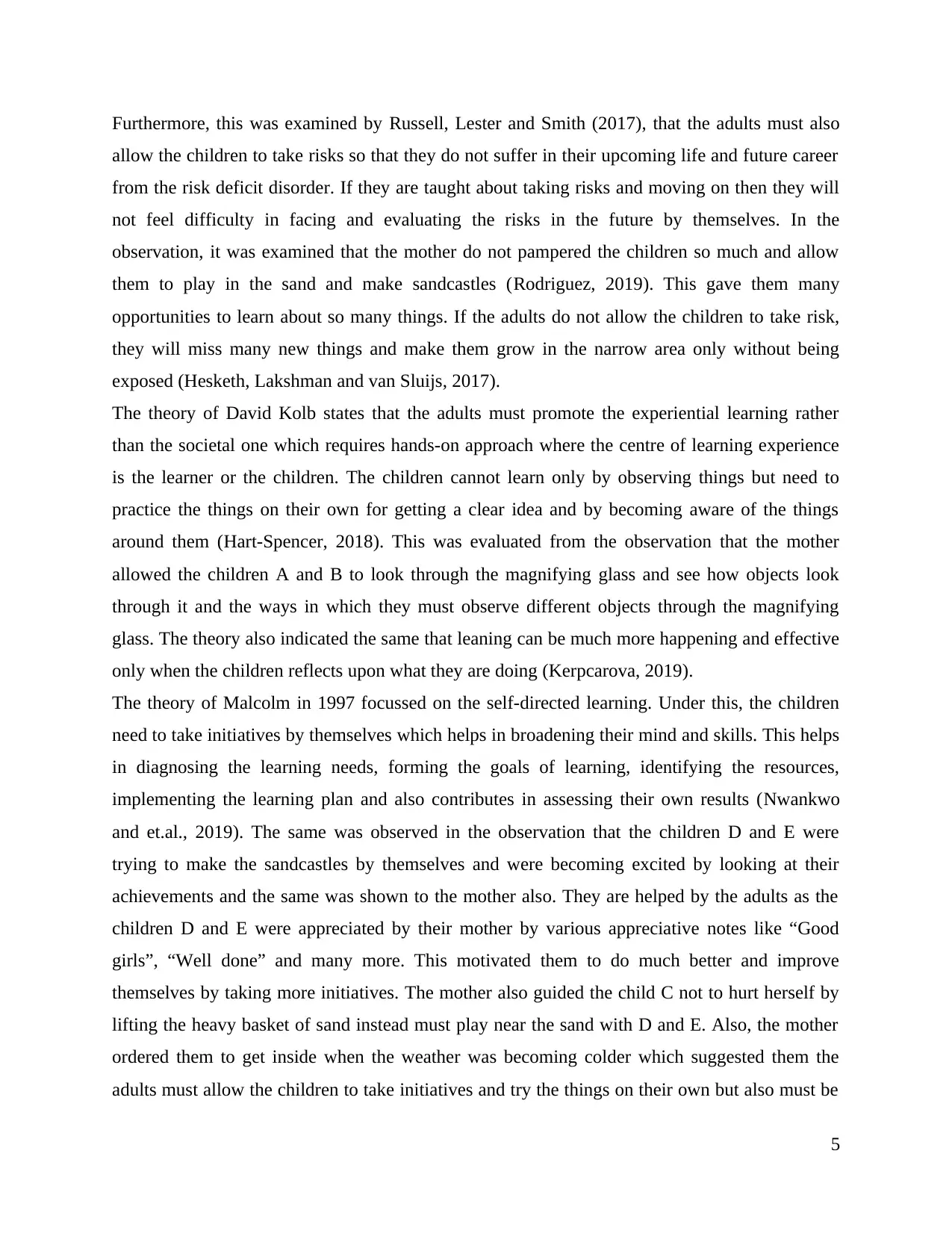
Furthermore, this was examined by Russell, Lester and Smith (2017), that the adults must also
allow the children to take risks so that they do not suffer in their upcoming life and future career
from the risk deficit disorder. If they are taught about taking risks and moving on then they will
not feel difficulty in facing and evaluating the risks in the future by themselves. In the
observation, it was examined that the mother do not pampered the children so much and allow
them to play in the sand and make sandcastles (Rodriguez, 2019). This gave them many
opportunities to learn about so many things. If the adults do not allow the children to take risk,
they will miss many new things and make them grow in the narrow area only without being
exposed (Hesketh, Lakshman and van Sluijs, 2017).
The theory of David Kolb states that the adults must promote the experiential learning rather
than the societal one which requires hands-on approach where the centre of learning experience
is the learner or the children. The children cannot learn only by observing things but need to
practice the things on their own for getting a clear idea and by becoming aware of the things
around them (Hart-Spencer, 2018). This was evaluated from the observation that the mother
allowed the children A and B to look through the magnifying glass and see how objects look
through it and the ways in which they must observe different objects through the magnifying
glass. The theory also indicated the same that leaning can be much more happening and effective
only when the children reflects upon what they are doing (Kerpcarova, 2019).
The theory of Malcolm in 1997 focussed on the self-directed learning. Under this, the children
need to take initiatives by themselves which helps in broadening their mind and skills. This helps
in diagnosing the learning needs, forming the goals of learning, identifying the resources,
implementing the learning plan and also contributes in assessing their own results (Nwankwo
and et.al., 2019). The same was observed in the observation that the children D and E were
trying to make the sandcastles by themselves and were becoming excited by looking at their
achievements and the same was shown to the mother also. They are helped by the adults as the
children D and E were appreciated by their mother by various appreciative notes like “Good
girls”, “Well done” and many more. This motivated them to do much better and improve
themselves by taking more initiatives. The mother also guided the child C not to hurt herself by
lifting the heavy basket of sand instead must play near the sand with D and E. Also, the mother
ordered them to get inside when the weather was becoming colder which suggested them the
adults must allow the children to take initiatives and try the things on their own but also must be
5
allow the children to take risks so that they do not suffer in their upcoming life and future career
from the risk deficit disorder. If they are taught about taking risks and moving on then they will
not feel difficulty in facing and evaluating the risks in the future by themselves. In the
observation, it was examined that the mother do not pampered the children so much and allow
them to play in the sand and make sandcastles (Rodriguez, 2019). This gave them many
opportunities to learn about so many things. If the adults do not allow the children to take risk,
they will miss many new things and make them grow in the narrow area only without being
exposed (Hesketh, Lakshman and van Sluijs, 2017).
The theory of David Kolb states that the adults must promote the experiential learning rather
than the societal one which requires hands-on approach where the centre of learning experience
is the learner or the children. The children cannot learn only by observing things but need to
practice the things on their own for getting a clear idea and by becoming aware of the things
around them (Hart-Spencer, 2018). This was evaluated from the observation that the mother
allowed the children A and B to look through the magnifying glass and see how objects look
through it and the ways in which they must observe different objects through the magnifying
glass. The theory also indicated the same that leaning can be much more happening and effective
only when the children reflects upon what they are doing (Kerpcarova, 2019).
The theory of Malcolm in 1997 focussed on the self-directed learning. Under this, the children
need to take initiatives by themselves which helps in broadening their mind and skills. This helps
in diagnosing the learning needs, forming the goals of learning, identifying the resources,
implementing the learning plan and also contributes in assessing their own results (Nwankwo
and et.al., 2019). The same was observed in the observation that the children D and E were
trying to make the sandcastles by themselves and were becoming excited by looking at their
achievements and the same was shown to the mother also. They are helped by the adults as the
children D and E were appreciated by their mother by various appreciative notes like “Good
girls”, “Well done” and many more. This motivated them to do much better and improve
themselves by taking more initiatives. The mother also guided the child C not to hurt herself by
lifting the heavy basket of sand instead must play near the sand with D and E. Also, the mother
ordered them to get inside when the weather was becoming colder which suggested them the
adults must allow the children to take initiatives and try the things on their own but also must be
5
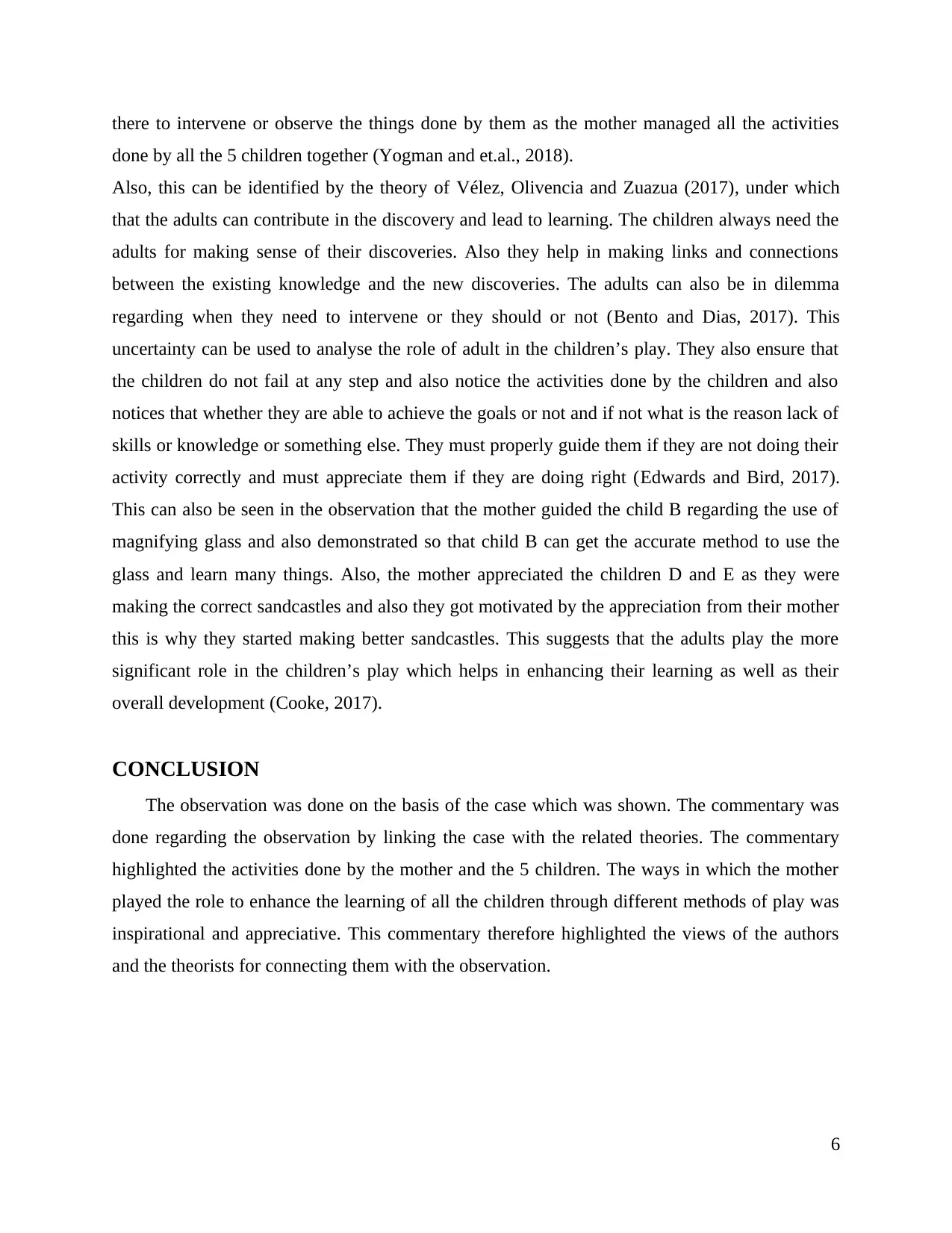
there to intervene or observe the things done by them as the mother managed all the activities
done by all the 5 children together (Yogman and et.al., 2018).
Also, this can be identified by the theory of Vélez, Olivencia and Zuazua (2017), under which
that the adults can contribute in the discovery and lead to learning. The children always need the
adults for making sense of their discoveries. Also they help in making links and connections
between the existing knowledge and the new discoveries. The adults can also be in dilemma
regarding when they need to intervene or they should or not (Bento and Dias, 2017). This
uncertainty can be used to analyse the role of adult in the children’s play. They also ensure that
the children do not fail at any step and also notice the activities done by the children and also
notices that whether they are able to achieve the goals or not and if not what is the reason lack of
skills or knowledge or something else. They must properly guide them if they are not doing their
activity correctly and must appreciate them if they are doing right (Edwards and Bird, 2017).
This can also be seen in the observation that the mother guided the child B regarding the use of
magnifying glass and also demonstrated so that child B can get the accurate method to use the
glass and learn many things. Also, the mother appreciated the children D and E as they were
making the correct sandcastles and also they got motivated by the appreciation from their mother
this is why they started making better sandcastles. This suggests that the adults play the more
significant role in the children’s play which helps in enhancing their learning as well as their
overall development (Cooke, 2017).
CONCLUSION
The observation was done on the basis of the case which was shown. The commentary was
done regarding the observation by linking the case with the related theories. The commentary
highlighted the activities done by the mother and the 5 children. The ways in which the mother
played the role to enhance the learning of all the children through different methods of play was
inspirational and appreciative. This commentary therefore highlighted the views of the authors
and the theorists for connecting them with the observation.
6
done by all the 5 children together (Yogman and et.al., 2018).
Also, this can be identified by the theory of Vélez, Olivencia and Zuazua (2017), under which
that the adults can contribute in the discovery and lead to learning. The children always need the
adults for making sense of their discoveries. Also they help in making links and connections
between the existing knowledge and the new discoveries. The adults can also be in dilemma
regarding when they need to intervene or they should or not (Bento and Dias, 2017). This
uncertainty can be used to analyse the role of adult in the children’s play. They also ensure that
the children do not fail at any step and also notice the activities done by the children and also
notices that whether they are able to achieve the goals or not and if not what is the reason lack of
skills or knowledge or something else. They must properly guide them if they are not doing their
activity correctly and must appreciate them if they are doing right (Edwards and Bird, 2017).
This can also be seen in the observation that the mother guided the child B regarding the use of
magnifying glass and also demonstrated so that child B can get the accurate method to use the
glass and learn many things. Also, the mother appreciated the children D and E as they were
making the correct sandcastles and also they got motivated by the appreciation from their mother
this is why they started making better sandcastles. This suggests that the adults play the more
significant role in the children’s play which helps in enhancing their learning as well as their
overall development (Cooke, 2017).
CONCLUSION
The observation was done on the basis of the case which was shown. The commentary was
done regarding the observation by linking the case with the related theories. The commentary
highlighted the activities done by the mother and the 5 children. The ways in which the mother
played the role to enhance the learning of all the children through different methods of play was
inspirational and appreciative. This commentary therefore highlighted the views of the authors
and the theorists for connecting them with the observation.
6
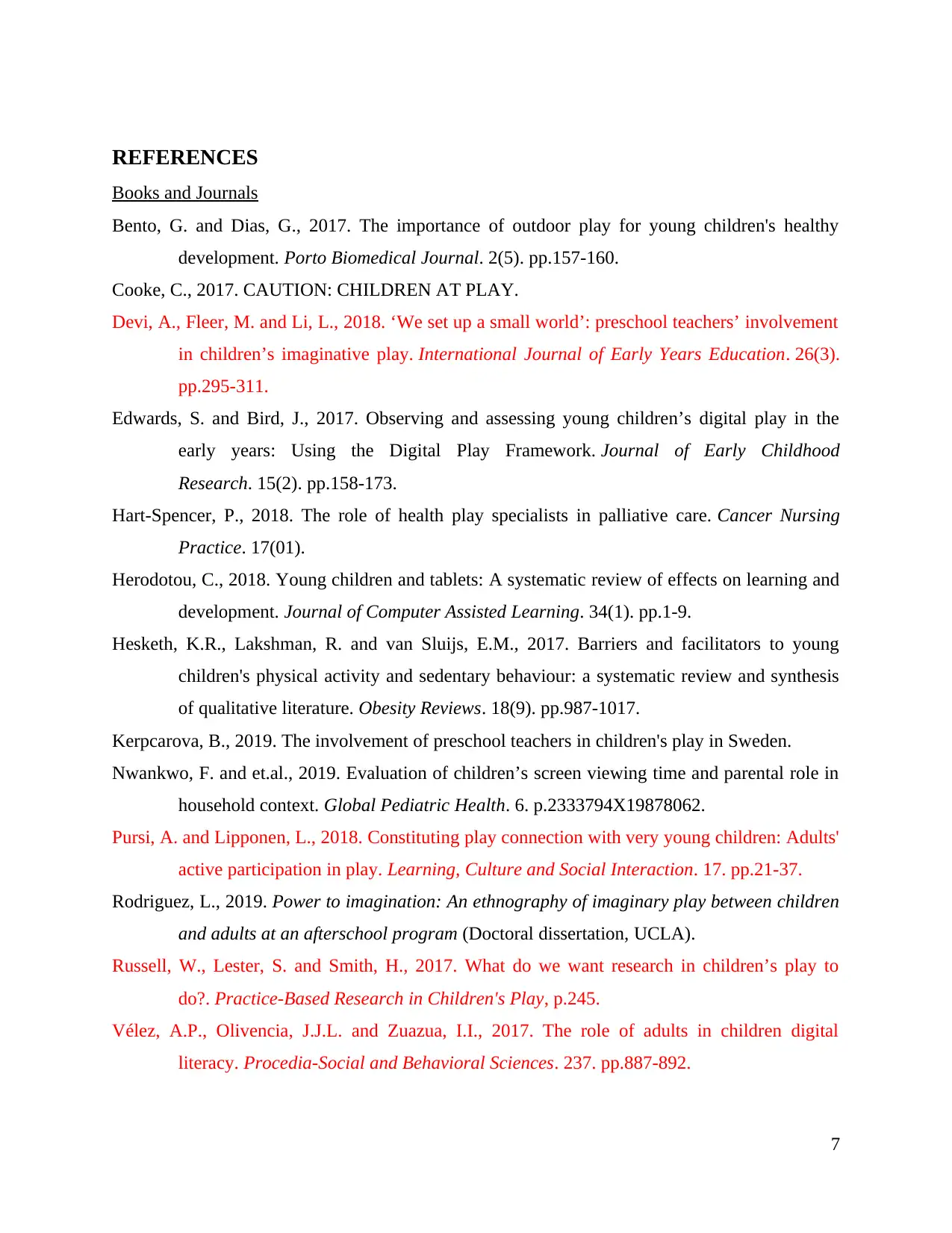
REFERENCES
Books and Journals
Bento, G. and Dias, G., 2017. The importance of outdoor play for young children's healthy
development. Porto Biomedical Journal. 2(5). pp.157-160.
Cooke, C., 2017. CAUTION: CHILDREN AT PLAY.
Devi, A., Fleer, M. and Li, L., 2018. ‘We set up a small world’: preschool teachers’ involvement
in children’s imaginative play. International Journal of Early Years Education. 26(3).
pp.295-311.
Edwards, S. and Bird, J., 2017. Observing and assessing young children’s digital play in the
early years: Using the Digital Play Framework. Journal of Early Childhood
Research. 15(2). pp.158-173.
Hart-Spencer, P., 2018. The role of health play specialists in palliative care. Cancer Nursing
Practice. 17(01).
Herodotou, C., 2018. Young children and tablets: A systematic review of effects on learning and
development. Journal of Computer Assisted Learning. 34(1). pp.1-9.
Hesketh, K.R., Lakshman, R. and van Sluijs, E.M., 2017. Barriers and facilitators to young
children's physical activity and sedentary behaviour: a systematic review and synthesis
of qualitative literature. Obesity Reviews. 18(9). pp.987-1017.
Kerpcarova, B., 2019. The involvement of preschool teachers in children's play in Sweden.
Nwankwo, F. and et.al., 2019. Evaluation of children’s screen viewing time and parental role in
household context. Global Pediatric Health. 6. p.2333794X19878062.
Pursi, A. and Lipponen, L., 2018. Constituting play connection with very young children: Adults'
active participation in play. Learning, Culture and Social Interaction. 17. pp.21-37.
Rodriguez, L., 2019. Power to imagination: An ethnography of imaginary play between children
and adults at an afterschool program (Doctoral dissertation, UCLA).
Russell, W., Lester, S. and Smith, H., 2017. What do we want research in children’s play to
do?. Practice-Based Research in Children's Play, p.245.
Vélez, A.P., Olivencia, J.J.L. and Zuazua, I.I., 2017. The role of adults in children digital
literacy. Procedia-Social and Behavioral Sciences. 237. pp.887-892.
7
Books and Journals
Bento, G. and Dias, G., 2017. The importance of outdoor play for young children's healthy
development. Porto Biomedical Journal. 2(5). pp.157-160.
Cooke, C., 2017. CAUTION: CHILDREN AT PLAY.
Devi, A., Fleer, M. and Li, L., 2018. ‘We set up a small world’: preschool teachers’ involvement
in children’s imaginative play. International Journal of Early Years Education. 26(3).
pp.295-311.
Edwards, S. and Bird, J., 2017. Observing and assessing young children’s digital play in the
early years: Using the Digital Play Framework. Journal of Early Childhood
Research. 15(2). pp.158-173.
Hart-Spencer, P., 2018. The role of health play specialists in palliative care. Cancer Nursing
Practice. 17(01).
Herodotou, C., 2018. Young children and tablets: A systematic review of effects on learning and
development. Journal of Computer Assisted Learning. 34(1). pp.1-9.
Hesketh, K.R., Lakshman, R. and van Sluijs, E.M., 2017. Barriers and facilitators to young
children's physical activity and sedentary behaviour: a systematic review and synthesis
of qualitative literature. Obesity Reviews. 18(9). pp.987-1017.
Kerpcarova, B., 2019. The involvement of preschool teachers in children's play in Sweden.
Nwankwo, F. and et.al., 2019. Evaluation of children’s screen viewing time and parental role in
household context. Global Pediatric Health. 6. p.2333794X19878062.
Pursi, A. and Lipponen, L., 2018. Constituting play connection with very young children: Adults'
active participation in play. Learning, Culture and Social Interaction. 17. pp.21-37.
Rodriguez, L., 2019. Power to imagination: An ethnography of imaginary play between children
and adults at an afterschool program (Doctoral dissertation, UCLA).
Russell, W., Lester, S. and Smith, H., 2017. What do we want research in children’s play to
do?. Practice-Based Research in Children's Play, p.245.
Vélez, A.P., Olivencia, J.J.L. and Zuazua, I.I., 2017. The role of adults in children digital
literacy. Procedia-Social and Behavioral Sciences. 237. pp.887-892.
7
Paraphrase This Document
Need a fresh take? Get an instant paraphrase of this document with our AI Paraphraser
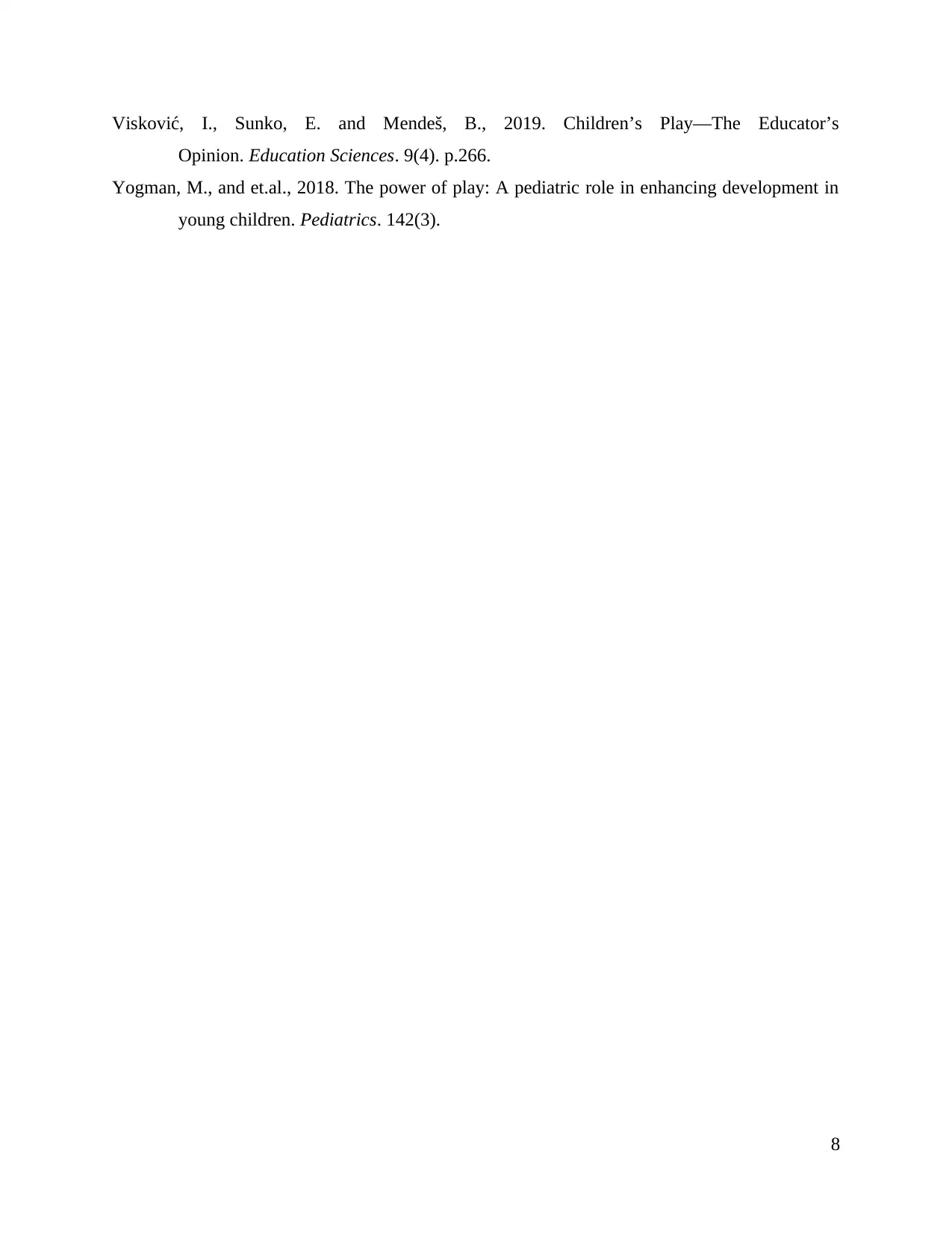
Visković, I., Sunko, E. and Mendeš, B., 2019. Children’s Play—The Educator’s
Opinion. Education Sciences. 9(4). p.266.
Yogman, M., and et.al., 2018. The power of play: A pediatric role in enhancing development in
young children. Pediatrics. 142(3).
8
Opinion. Education Sciences. 9(4). p.266.
Yogman, M., and et.al., 2018. The power of play: A pediatric role in enhancing development in
young children. Pediatrics. 142(3).
8
1 out of 8
Your All-in-One AI-Powered Toolkit for Academic Success.
+13062052269
info@desklib.com
Available 24*7 on WhatsApp / Email
![[object Object]](/_next/static/media/star-bottom.7253800d.svg)
Unlock your academic potential
© 2024 | Zucol Services PVT LTD | All rights reserved.


